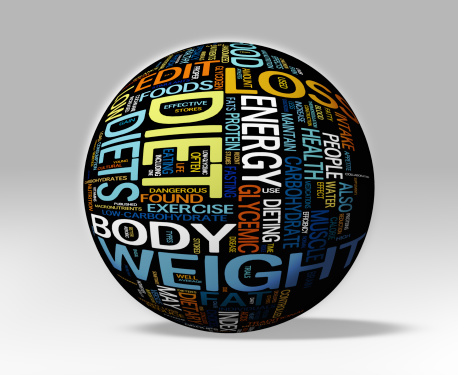
The Psychology of Weight Loss
By: Lynn Bode, CFT
Losing weight requires more than a physical commitment – the mental aspect is also vitally important. When it comes to fitness, the mind truly is a powerful thing.
Have doubts that there is a mind-body connection to wellness?
Simply try this easy test: do a workout of your choice (running, walking, lifting weights) with your favorite pump-up music. Then do it a separate time with no music at all. You’ll quickly see how the simplicity of motivating music can help you go farther, faster or simply feel stronger during your routine. That’s the power of your mind!
Why is the mind-body connection important to understand? Because, the wrong mental approach to getting more fit can have powerful negative effects. A huge amount of dieters quit their weight loss plans because of psychological reasons.
What you think can create what you are. Your personal self-talk is crucial in determining whether or not you are successful at reaching your weight loss and fitness goals. Continual negative thoughts can create a self-fulfilling prophecy. If daily you bombard yourself with self-defeating thoughts, then eventually you will begin to believe them.
When you tell yourself such things as “I’m always going to be fat” or “I can’t stop eating” or “I can’t walk that mile”, then naturally you’ll start to believe the myths as factual. From there you have immediately set the stage for failure.
So, how can you dig out of the seemingly endless downward spiral of negative thoughts and feelings? Start with these six important psychological exercises:
Create a list of all the negative thoughts that you have about yourself.
Then create a second list of all the things that you like about yourself.
Keep working on your positive list until it is much longer than your negative list. We all tend to be our worst critics, so this can be a challenging exercise. Write down even little things like “I can make a great cheese sandwich”, or “I always get to work on time”.
Take your list of negatives and change all of them to positive potentials. For example, instead of “I always fail at losing weight” change it to “I can succeed at weight loss.” Or, instead of “I can’t stop eating”, change it to “I will control my portions.” Destroy your negative list and only keep the new potentials list.
Stop using these words: can’t, won’t, never. Replace them with: can, will, always.
Forget the past. That piece of cake you ate yesterday is old news. Forget about it and move on. Live only in the present. You can’t change what you did even an hour ago. All you can do is resolve to stay focused and committed right now and try to keep that focus tomorrow too.
Stop making excuses for why you can’t exercise and eat right. Start by making a list of all of your steadfast excuses and also all the reasons that you should workout. The list of reasons why you should exercise inarguably should be much longer. Post your list of reasons where you can see it daily.
Stop the blame game. Promise to take self-responsibility. It’s easy to blame your genes, your diet-plan or even your family for your failed diet attempts. But not accepting full responsibility will simply keep you trapped in a repetitive loop of failures.
About the author: Lynn Bode is a certified personal trainer specializing in Internet-based fitness programs. She founded Workouts For You, which provides affordable online exercise programs that are custom designed for each individual. Visit: http://www.workoutsforyou.com for free fitness
tips and a sample workout program. Fitness professionals, learn how to support your clients online, visit: http://www.trainerforce.com
Inflammation and Kids
By Carol Simontacch, CCN, MSInflammation is a problem of the aging, isn’t it? I remember how my grandparents’ fingers gnarled painfully as they aged. My grandmother struggled to get out of a chair each evening. She popped aspirin like candy. Aspirin was the only pain reliever available at that time. We often think that arthritis and other “diseases of pain” are a natural and expected consequence of the aging population. But research and clinical data reveal that inflammation is a problem of the elderly – and the very young. Pain in the joints and soft tissues can afflict sedentary and unhealthy people – and young men and women who are passionate about health.
We find that inflammation is at the heart of virtually every disease condition we talk about, including fibromyalgia, chronic fatigue syndrome, metabolic syndrome, heart disease, diseases of the brain, osteoporosis and of course, the arthritis conditions. Because these illnesses are so pervasive – and can begin so early in life, we need to address this issue early. Our children are being set up for major illnesses as they grow older because of chronic inflammation starting in childhood.
What does the research say? Fat tissue releases pro-inflammatory immune bodies, which potentially induce low-grade systemic inflammation in persons with excess body fat. In a study of over 3500 children, eight to sixteen years of age, researchers found both elevated C-reactive protein concentrations and white blood cell counts in over seven percent of the boys and over six percent in the girls.(Visser)
Obesity, low physical fitness, and inactivity are associated with cardiovascular risk factors and coronary artery disease (CAD). Researchers are finding this relationship in children as well as adults. They are also discovering chronic inflammation as a relationship between obesity and CAD. In a small study of 197 children, ranging from ten- to fifteen-year-olds, the obese children had significantly higher concentrations of inflammatory parameters and the obese, unfit children had the highest systemic inflammation. (Halle)
How could the tissues of young children and teenagers become inflamed? Consider the child who awakens in the morning to a bowl of cereal that contains more sugar, ounce-per-ounce, than soft drinks. She moistens the cereal with milk and sprinkles another spoonful of sugar over the top. She enjoys a piece of toast, spread thickly with jam that contains far more sugar than fruit, and washes it down with a glass of Tang (that contains no orange juice at all).
For lunch, she enjoys a packaged entrée (mostly chemicals, sodium and sugar) and a soft drink. Mom packed a bundle of cookies (for love) which she enjoyed for her mid-afternoon snack.
Dinner is hamburgers or pot roast, a small salad with ranch dressing and dessert. Her diet is almost completely inflammatory. This child, and all the children like her, are being set up for the conditions listed above, all of which have their roots in inflammation.
Does this picture change as the child matures? Hardly. Consider the teenager who skips breakfast after getting too little sleep. He is hungry by mid-morning so he stuffs coins into the vending machine at school for a soft drink and a candy bar. For lunch, he buys a slice or two at the local pizzeria that is conveniently located by the school and washes it down with another soft drink. After school, he snacks on chips and burgers, and wolfs down several pieces of deep fried chicken and a pile of French fries for dinner. Dessert is a pint of ice cream. All pro-inflammatory, including the sleep deprivation.
Helping Dad Be Dad
As a nutritionist, I often work with parents who are trying to optimize their childrens’ health. We review their food diaries that often looks like what is described above. I make suggestions: remove all processed foods and replace them with fresh fruits and vegetables, take the soft drinks and artificial drinks out of the house, replace them with water, and include a variety of proteins and fat—including fish oils, olive oil, organic chicken, wild-raised seafood and other high quality proteins.
They stare at me in disbelief. “But he won’t eat that,” they protest. It is a good thing I do not charge for my counseling services because they would be muttering, “And I paid for this…”
The good new in all of this is that we can restore health to our children. The first step in building lifelong heath in children is to feed them properly. Fortunately, that is not as hard as it sounds – if you can teach them to ignore the commercials and peer pressure that drive many of their eating behaviors. And just to make it easier, a sample menu, is designed for children and teenagers, follows.
Breakfast
Breakfast burritos, with scrambled eggs, mashed avocado, diced tomatoes, refried beans, and a handful of lettuce. Top with salsa and serve on a corn tortilla. (Delicious!)
Lunch
Small dinner salad with several kinds of vegetables, with his favorite dressing. Small chunks of oven-roasted chicken for protein, and a piece of fresh fruit for dessert.
After-school snack
Rice cake with almond butter and fruit-only jam. Fresh fruit or a vegetable platter with their favorite dressing. Popcorn with butter and a sprinkling of salt.
Dinner
Wild-raised fish prepared as oven-baked fish sticks with tartar sauce. Side salad of fresh cole slaw, a baked sweet potato and stir-fried green beans topped with soy sauce and a sprinkle of sesame seeds. Want dessert? Offer fresh fruit.
This menu is good for children, teenagers, and adults. Best of all, it helps your children maintain healthy weight, a healthy cardiovascular system and is anti-inflammatory.
What About Supplements for Children and Teens?
Children and teenagers can generally take the same supplements as adults, but in smaller amounts if their body weight is under one-half the adult weight. If your children are starting to complain of achy joints and muscles, add a fish oil supplement to their diets.
Because most North American children are deficient in minerals, I strongly urge parents to include a good quality mineral supplement, but if inflammation is an issue, a supplement like SierraSil™ is very appropriate for children. SierraSil is a blend of over three dozen naturally occurring minerals, mined from a unique clay deposit in the Sierra Nevada Mountains.
Two human trials have shown that the compound is uniquely anti-inflammatory. For children are under the age of ten, with a body weight less than 100 pounds, I recommend lowering the dosage to 1-2 capsules per day, taken on an empty stomach. If they cannot swallow a capsule, the contents can be emptied into a smoothie each morning. Make it icy cold, thick with frozen fruit and ice chips, to reduce any grittiness. The minerals in the SierraSil will dampen down residual inflammation.
The time to lower inflammation in children and teenagers is while they are still young. Don’t wait for arthritis to settle into the tissues.
Bibliography
Halle M, Korsten-Reck U, Wolfarth B et al. “Low-grade systemic inflammation in overweight children: impact of physical fitness.” Exerc Immunol Rev. 2004;10:66-74
Visser M, Bouler LM, McQuillan GM, et al. “Low Grade Systemic Inflammation in Over-Weight Children.” Pediatrics,201;107(1):E13.



